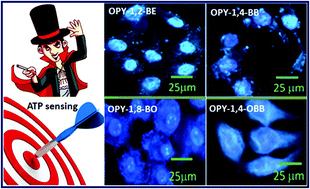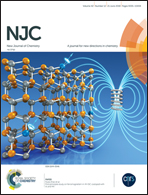Multiple cation-doped linear polymers toward ATP sensing and a cell imaging application†
Abstract
A set of multiple cation-doped linear polymers (abbreviated as OPY-1,2-BE, OPY-1,4-BB, OPY-1,8-BO, OPY-1,4-OBB) synthesized from a dipyridine derivative (OPY) and dibrominated compounds were employed as fluorescent probes for adenosine triphosphate (ATP) sensing. Among them, OPY-1,8-BO is particularly able to recognize ATP over its related compounds adenosine diphosphate (ADP), adenosine monophosphate (AMP), and other phosphate anions, with very desirable switch off–on performances. The interesting phenomenon of aggregate-induced emission (AIE) is proposed as the main reason for the ATP sensing, which is due to the ATP being more negative than the polymers and therefore there is more opportunity for connections with the multiple cation doped polymers through electrostatic attractions. Cell imaging measurements were carried out and demonstrated that even though these probes bear the same OPY core and only slightly different linkers, they are able to image different cell environments. The controlled cell imaging verified that the OPY-1,8-BO probe has ATP-specific recognition in living cells.



 Please wait while we load your content...
Please wait while we load your content...